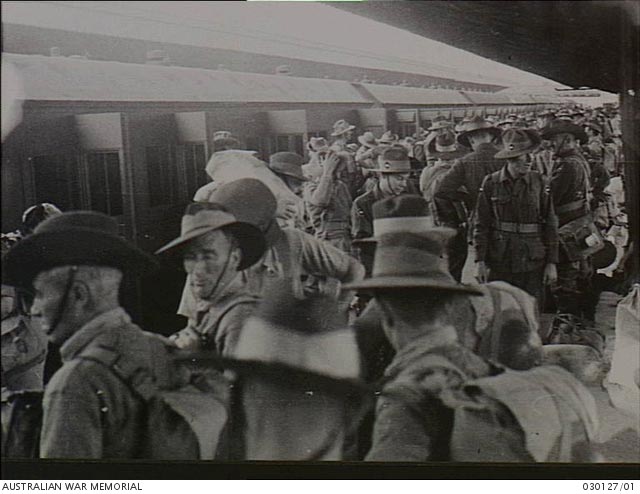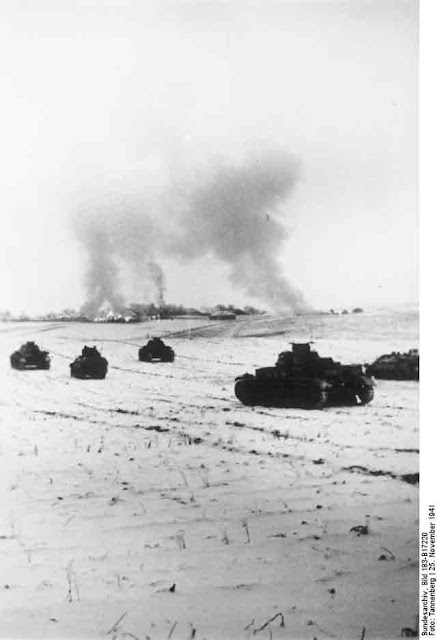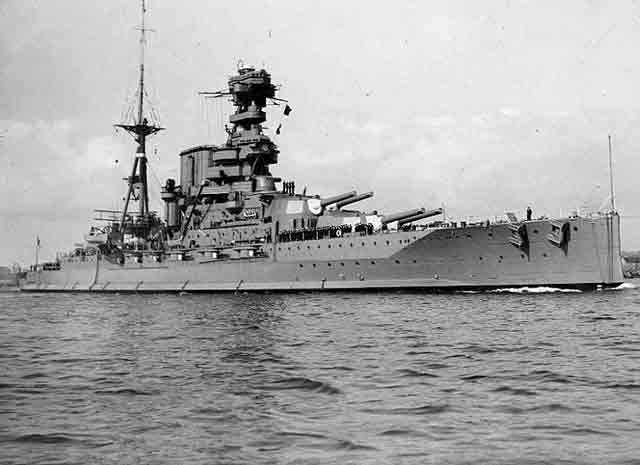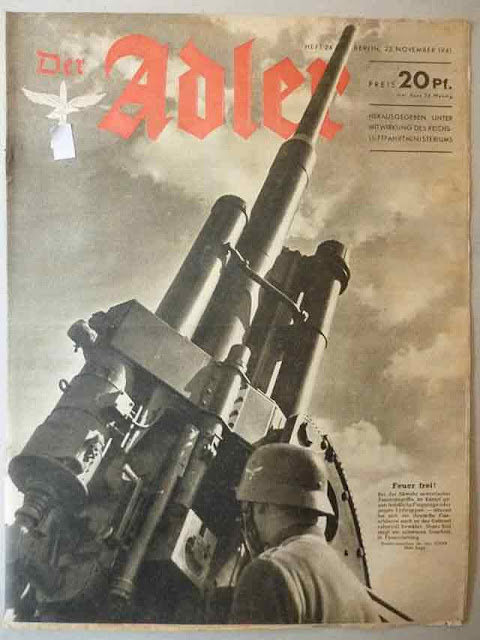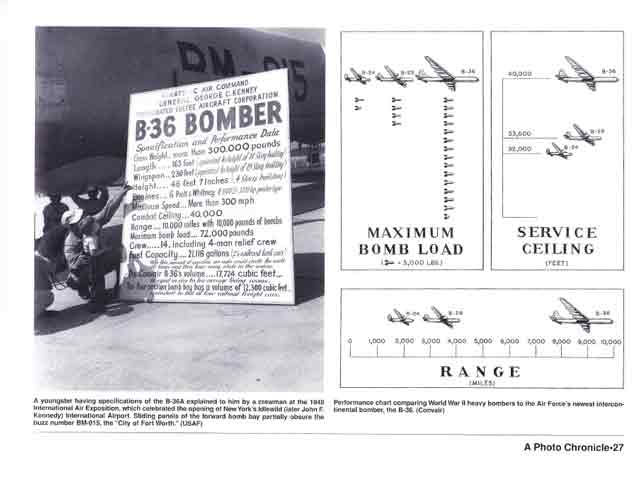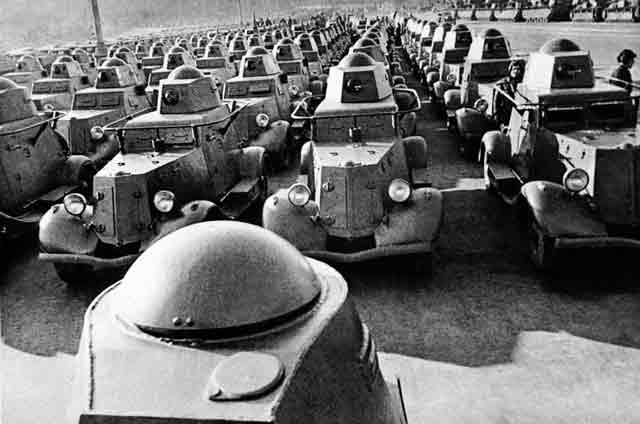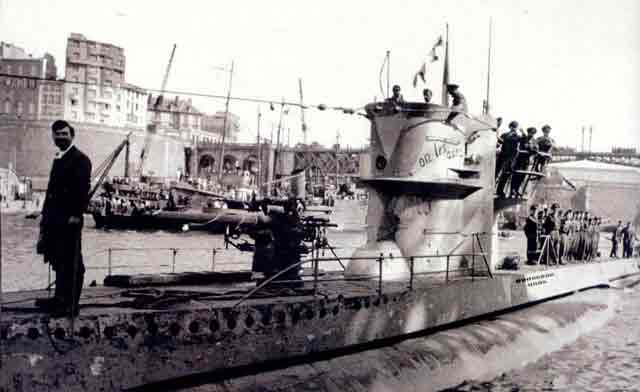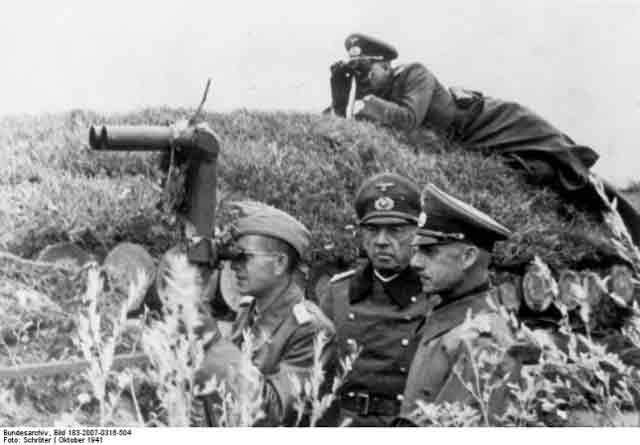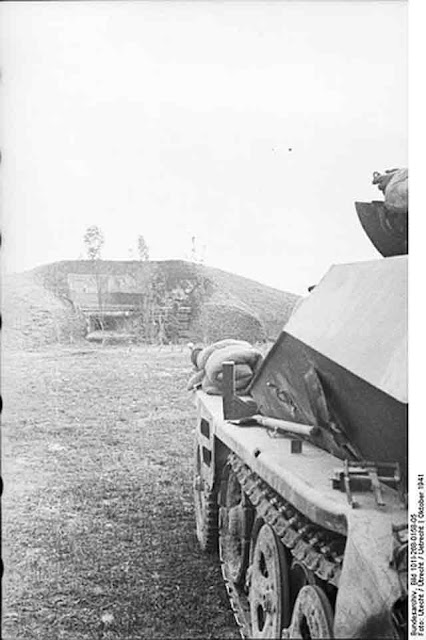Monday 16 March 1942
 |
| U-502 arrives back in port after a successful patrol during which it sank 33,800 tons of enemy shipping on 16 March 1942 (Moravia; Junkers, Federal Archive Figure 101II-MW-3810-20A). |
Battle of the Pacific: Just before midnight on 16 March 1942, General Douglas MacArthur, his family, and his staff finally receive planes to take them from Del Monte, Mindanao, Philippines, to Australia on 16 March 1942. Three B-17 bombers of the US Army 5th Air Force arrive for this mission but one requires repairs before it can make the return trip (defective supercharger). Lead pilot Lieutenant Frank P. Bostrom readies for a quick turnaround by drinking a pot of coffee. He informs the general that he and his party must leave behind any luggage - including Mrs. MacArthur's prized mattress which she brought from Corregidor.
Japanese siege guns continue bombarding US Army forts on their fortified islands near Manila. The Japanese have emplaced additional artillery southwest of Temate and US counterbattery fire is ineffective. Already, several US guns have been knocked out at Forts Drum and Frank. The Japanese guns range up in size to 240 mm, and one shell hits a Fort Frank powder room but somehow fails to detonate the 60 filled powder cans inside. US Navy submarine USS Permit arrives at Corregidor Island to evacuate naval radio and communications intelligence soldiers.
 |
| The happy crew of U-502 as it arrives back at Lorient on 16 March 1942. Note the victory pennants signifying a successful patrol. (Moravia; Junkers, Federal Archive Figure 101II-MW-3810-24A). |
The Germans need Operation Raubtier to end quickly so that they transfer the forces there to relieve the men trapped in the Demyansk pocket. In the pocket, General Walter von Brockdorff-Ahlefeldt, commander of the II Army Corps, has been talking about staging a desperate breakout to the west. To reassure him, Army Group North commander Georg von Küchler makes an unusually risky flight for an army group commander. He flies into the Demyansk pocket. During the flights in and out, Küchler makes personal observations about the relative positions of the two forces. He sees that the Soviets are attacking from the north and south, which means that an attack from the west might well succeed. Still, the relief attack will have to cover a full 20 miles, no small feat in the snowy or, if the attack is postponed too long, boggy terrain.
 |
| "A captured German Mk IV tank is examined back at base in the Western Desert, 16 March 1942." © IWM (E 9309). |
European Air Operations: It is a very quiet night on the Channel Front. There are standard anti-shipping sweeps during the day but no bombing missions.
 |
| The commander of U-502, Kptlt. Jürgen von Rosenstiel, on deck after his boat docks in Lorient on 16 March 1942 (Moravia; Junkers, Federal Archive Figure 101II-MW-3810-26A). |
U-68 (KrvKpt. Karl-Friedrich Merten), on its third patrol out of Lorient, torpedoes and sinks 3386-ton British freighter Baron Newlands six miles south of Cape Palmas, Liberia. The ship is sunk after a difficult pursuit through a thunderstorm. There are 20 survivors and 18 deaths. The survivors apparently managed to swim to shore or clung to flotsam and jetsam as no lifeboats were launched.
 |
| Dutch tanker Oscilla, sunk near the Windward Islands on 16 March 1942. |
Italian submarine Morosini also (apparently it is the Morosini, this is not confirmed) torpedoes and sinks 2802-ton British freighter Manaqui northeast of Barbuda. Morosini is known to be operating in this area. There are 41 dead. Another candidate for this sinking is U-504.
U-504 (KrvKpt. Hans-Georg Friedrich Poske), on its second patrol out of Lorient, torpedoes and sinks 5966-ton British freighter Stangarth about 300 miles north of San Juan, Puerto Rico. The ship, which is carrying ammunition and other military goods, explodes and sinks immediately. All 46 men on the Stangarth perish. Another candidate for this sinking is the Morosini.
 |
| "Commissioning of USS Impulse, formerly the British corvette HMS Begonia. 16 March 1942, Albert Dock." USS Impulse served with the US Navy until being returned to the Royal Navy in 1945. © IWM (A 7789). |
German 2642-ton freighter Utlandshorn hits a mine and sinks in the waters off northern Norway (Grense Jakobselv). The ship apparently is supplying the German garrison at Pechenga. Casualties are not recorded.
German harbor defense vessel (patrol boat) HS-97 hits a mine and sinks near Dunkirk. No details on this one.
British 430-ton freighter Miriam Thomas collides with Admiralty Hospital Ship Vasna and sinks about 15 miles south of Chicken Rocks near Holyhead, UK. All eight men aboard perish.
Dutch 4539-ton freighter Alcyone hits a mine and sinks 18 miles off Green Point, Capetown, South Africa. The mine was laid by the Speybank, a captured ship being used by the Germans. There are 46 deaths.
British 4270-ton freighter Cressdene hits a mine and is severely damaged near Swansea, UK. It sinks while under tow on the 17th. Details are scarce on this ship.
 |
| "The gun turret of a Matilda tank that had been captured [by Axis forces] and concreted into position to be used as part of the defenses of Halfaya Pass, 16 March 1942. A Valentine tank passes by in the background." © IWM (E 9320). |
Italian submarine Galatea uses its deck gun to sink a small sailing vessel off the Palestinian coast.
The situation on Malta is critical in certain vital areas that the Axis air forces have targeted. Ta Qali Airfield, in particular, is in trouble due to incessant bombing attacks. In addition, the field has to be modified for the use of new Spitfire squadrons. The island government sends out a request for volunteers to help with this work.
Royal Navy submarine HMS Ultimatum (P 32) arrives in Malta with 14 Italian survivors of its 14 March 1942 sinking of Italian submarine Ammiraglio Millo in the Ionian Sea off Punta (Cape) Stilo, Calabria, Italy. Commander Harrison of the Ultimatum makes a quick turnaround and departs for a new patrol on 17 March.
 |
| Dr. Seuss cartoon from 16 March 1942. Image from Dr. Seuss Went to War (Mandeville Special Collections Library, UC San Diego). |
The activity of the partisans has increased notably in recent weeks. They are conducting a well-organized guerilla war.The Germans at the front are busy preparing "Operation Munich," an anti-partisan sweep set to begin on 19 March 1942. This is planned as a large-scale operation to include a special air detachment established Bobruisk on 14 March 1942. Another such mission in the same general area set to begin later in March 1942 is Operation Bamberg.
Anglo/US Relations: President Roosevelt cables Prime Minister Winston Churchill with an offer to send a large US Navy force ("two battleships, two cruisers, an aircraft carrier, and a squadron of destroyers") to homeland British bases such as Scapa Flow. He notes that recent tanker sinkings are "very disturbing." He promises that by 1 July 1942 "our mounting production of small escort vessels and planes will come fully into play."
 |
| Time magazine, 16 March 1942. The cover story, "The Viceroy of India." Cover credit: Ernest Hamlin Baker. |
Anglo/Soviet Relations: The Soviet Ambassador to Great Britain repeats Joseph Stalin's repeated request that the western Allies open a second front in Europe.
 |
| Life magazine, 16 March 1942. Note that the soldier on the cover is wearing a World War I helmet. |
The 39th Pursuit Squadron (Interceptor), 35th Pursuit Group (Interceptor), transfers from Ballarat to Mount Gambier with its P-39 fighters. The 64th Bombardment Squadron (Heavy), 43d Bombardment Group (Heavy), arrives at Sydney, Australia from the US with its B-17s. The 68th Pursuit Squadron (Interceptor), 58th Pursuit Group (Interceptor), arrives at Amberly Field, Australia from the US with its P-39s.
US Government: The Maritime Commission places orders for another 234 Liberty ships. These are generic freighters built according to a standard plan that prioritizes cheap parts and ease of construction. For instance, they use a 140-ton vertical triple expansion compound steam engine of obsolete design rather than modern steam engines because the latter type is more difficult to build and requires special tooling. Everybody, including President Roosevelt, makes fun of the Liberty ships and their ugly appearance, but they get the job done.
 |
| "The weather map from the morning of March 16th [1942] showed low pressure over central Oklahoma, with an associated warm front lifting northward across central Illinois. Temperatures were unseasonably warm across the area, rising into the mid to upper 70s by afternoon." National Weather Service. |
American Homefront: Powerful tornadoes hit the Central and Southern United States. States affected include Illinois, Indiana, Mississippi, Oklahoma, Kentucky, Alabama, South Carolina, and Tennessee. Many of these areas do not usually get tornadoes, so they come as real shocks. The outbreak goes on for almost three full days, with 149 fatalities and 1312 injuries. On the Fujita scale, some of the tornadoes score the maximum rating of tornado damage, with costly property damage.
 |
| The Lacon F5 Tornado of 16 March 1942. |
March 1942
March 1, 1942: Second Battle of Java Sea
March 2, 1942: Huge Allied Shipping Losses at Java
March 3, 1942: Japan Raids Western Australia
March 4, 1942: Second Raid On Hawaii
March 5, 1942: Japan Takes Batavia
March 6, 1942: Churchill Assaults Free Speech
March 7, 1942: British Defeat in Burma
March 8, 1942: Rangoon Falls to Japan
March 9, 1942: Japanese Conquest of Dutch East Indies
March 10, 1942:US Navy attacks Japanese Landings at Lae
March 11, 1942: Warren Buffett's First Stock Trade
March 12, 1942: Japan Takes Java
March 13, 1942: Soviets Attack In Crimea Again
March 14, 1942: The US Leans Toward Europe
March 15, 1942: Operation Raubtier Begins
March 16, 1942: General MacArthur Gets His Ride
March 17, 1942: MacArthur Arrives in Australia
March 18, 1942: Japan Attacks In Burma
March 19, 1942: Soviets Encircled on the Volkhov
March 20, 1942: "I Shall Return," Says MacArthur
March 21, 1942: Germans Attack Toward Demyansk
March 22, 1942: Second Battle of Sirte
March 23, 1942: Hitler's Insecurity Builds
March 24, 1942: Bataan Bombarded
March 25, 1942: Chinese Under Pressure in Burma
March 26, 1942: Win Or Die, Vows MacArthur
March 27, 1942: The Battle of Suusari
March 28, 1942: The St. Nazaire Commando Raid
March 29, 1942: The Free Republic of Nias
March 30, 1942: Japanese-Americans Off Bainbridge Island
March 31, 1942: Japanese Seize Christmas Island
2020







